Characteristics of the Gold-Decorated Wooden Sculptures of Qing Dynasty Collected in Qianjiang Cultural Administration Institute, Chongqing, China
Abstract
1. Introduction
2. Materials and Methods
2.1. Cultural Relics Information
2.2. Sample Information
2.3. Microscopy Analysis
2.4. SEM-EDS Analysis
2.5. Raman Spectroscopy Analysis
2.6. Slice Analysis
2.7. Wood Apecies Identification
2.8. Wood Composition Analysis
3. Results
3.1. Microscopy Observation Results
3.2. Raman Spectroscopy Analysis Results
3.3. SEM–EDS Analysis Results
3.4. Wood Analysis Results
4. Discussion
4.1. Assessment of the Preservation Status of Wood
4.2. Manufacturing Techniques and Decorative Processes
- (1)
- Forming the shape: the wooden core was carved from Cupressus wood to form the basic shape.
- (2)
- Decoration and processing: First, a putty made of a mixture clay and gypsum was used for priming, and then decorated by pigments. The main pigment found in these two wooden sculptures was red, composed of cinnabar and hematite.
- (3)
- Lacquer putty application: a lacquer putty, composed of finely ground and sieved brick dust mixed with raw lacquer, was applied to the wood sculptures.
- (4)
- Lacquer coating: multiple layers of lacquer were applied over the putty, including a black base lacquer (pigmented with carbon black) and a red lacquer layer (pigmented with cinnabar).
- (5)
- Gilding: gold leaf was applied onto the lacquer layer using traditional Chinese gilding technique called sticking gold.
4.3. Evidence of Restoration
Author Contributions
Funding
Institutional Review Board Statement
Informed Consent Statement
Data Availability Statement
Acknowledgments
Conflicts of Interest
References
- Zhou, S. Analysis of Corrosion Deformation Types and Mechanisms of Water-Saturated Wooden Cultural Relics. Jianghan Archaeol. 2014, S1, 51–56. [Google Scholar]
- Li, M. Research on the Degradation Mechanism and Chemical Protection of Rotten Silk Fabric Cultural Relics and Water-Saturated Bamboo and Wooden Cultural Relics. Ph.D. Thesis, Wuhan University, Wuhan, China, 2014. [Google Scholar]
- Chen, G.; Lu, Y.; Zhao, Y. Analysis of Corrosion Diseases and Mechanisms of Wooden Artifacts Unearthed from Mojuizi in Wuwei. Sci. Conserv. Archaeol. 2006, 2, 28–33. [Google Scholar] [CrossRef]
- Chen, G.; Lu, Y. Research on the Environmental Corrosion Effect and Mechanism of Rotten Wooden Artifacts Unearthed in Gansu Province. Sci. Conserv. Archaeol. 2009, 21, 67–73. [Google Scholar] [CrossRef]
- Chen, Z.; Wei, S.; Fu, Y.; Fang, Q. Analysis of Lacquer from the Zeng Cemetery (1046–771 BCE) at Guojiamiao. Coatings 2024, 14, 1559. [Google Scholar] [CrossRef]
- Chen, Z.; Wei, S.; Fu, Y. Pre-protection analysis of unearthed water-saturated lacquered woodware: With lacquered woodware unearthed from the Zeng Guo Cemetery of Guojiamiao, Hubei Province as examples. Res. Sq. 2021. preprint. [Google Scholar] [CrossRef]
- Jensen, P.; Jensen, J. Dynamic model for vacuum freeze-drying of waterlogged archaeological wooden artefacts. J. Cult. Heritage 2006, 7, 156–165. [Google Scholar] [CrossRef]
- Han, L.; Guo, J.; Tian, X.; Jiang, X.; Yin, Y. Evaluation of PEG and sugars consolidated fragile waterlogged archaeological wood using nanoindentation and ATR-FTIR imaging. Int. Biodeterior. Biodegrad. 2022, 170, 105390. [Google Scholar] [CrossRef]
- Rowell, R. Structure and Degradation Process for Waterlogged Archaeological Wood; American Chemical Society: Washington, DC, USA, 1990; pp. 35–50. [Google Scholar] [CrossRef]
- Liu, L.; Zhang, L.; Zhang, B.; Hu, Y. A comparative study of reinforcement materials for waterlogged wood relics in laboratory. J. Cult. Heritage 2019, 36, 94–102. [Google Scholar] [CrossRef]
- Lu, Z.; Wang, Y. A polychrome wooden sculpture with figure patterns of Liao Dynasty collected in Liaoning Provincial Museum. Steppe Cult. Relics 2017, 2, 98–107. [Google Scholar] [CrossRef]
- Dong, S. A polychrome wooden sculpture excavated from the White Elephant Pagoda of the Northern Song Dynasty. Cult. Relics East 2011, 3, 5–11. [Google Scholar]
- Cover Introduction: A seated statue of Guanyin Bodhisattva with painted wood carvings from the Song Dynasty. Collector 2019, 9, 1.
- Mo, L. On the Aesthetic Value of Chaozhou Wood Carvings in Guangdong Museum. Master’s Thesis, Guangdong University of Technology, Guangzhou, China, 2019. [Google Scholar] [CrossRef]
- Painted wooden carvings of seated Bodhisattvas. J. Natl. Mus. China 2018, 3, 161.
- Zhen, X. A Brief Analysis of the Characteristics of the polychrome wood Carvings in Shuanglin Temple. Appreciation 2017, 9, 289. [Google Scholar]
- Wu, H. An Analysis of the Wood Carvings of Figures from the Huaxi Pavilion in Bozhou during the Qing Dynasty. Tomorrow’s Fash. 2017, 5, 292. [Google Scholar]
- Huang, Q. Research on the Restoration of Small Box Buddha Wood Carvings of Standing Bodhisattvas in the Qing Dynasty. Art Mus. Mag. 2024, 4, 28–33. [Google Scholar]
- Xie, Y. Restoration Research on Standing Wooden Statues of Bodhisattvas from the Liao Dynasty collected by the Palace Museum. Cult. Relics World 2021, 12, 108–116. [Google Scholar]
- Xie, Y. Restoration Research on the Kuilong Pattern Luohan Bed Carved from Purple Sandalwood collected by the Palace Museum. China Cult. Herit. Sci. Res. 2021, 3, 65–71. [Google Scholar]
- Wang, Y. The Conservation and restoration of Chaozhou wood Carvings in the collection: Taking the through-carving, lacquered and gilded flower-and-bird pattern Board as an Example. Cult. Relics World 2016, 12, 46–48. [Google Scholar]
- Wang, J. The protection and restoration of the wooden Buddha statues unearthed from the Xiude Temple Pagoda in Quyang. In Proceedings of the 9th Academic Annual Conference of the China Association for Conservation Technology of Cultural Heritage, Hebei Provincial Cultural Relics Protection Center, Chongqing, China, 22–24 November 2016. [Google Scholar]
- Zhao, Y. The restoration of the Song Dynasty wooden standing Maitreya statue in Longxing Temple. Stories Relics 2002, 6, 61–65. [Google Scholar]
- Li, J. Replication and restoration of the lion head knob of the decorative piece “Purple Sandalwood Palace Fan Stand”. J. Jilin Univ. Arts 2010, 2, 25–28. [Google Scholar] [CrossRef]
- Lu, Y. Preliminary research on the Protection of Ming Dynasty Polychromoe Woodcarving Seated Statues in the collection. Sci. Conserv. Archaeol. 2014, 26, 57–68. [Google Scholar] [CrossRef]
- Lu, Y. The protection research and restoration of a Qing Dynasty lacquered and gilded wooden statue of Guanyin Bodhisattva. Sci. Conserv. Archaeol. 2016, 28, 38–46. [Google Scholar] [CrossRef]
- Li, G.; Xie, Y.; Zhang, X.; Wang, N.; Qu, F.; Lei, Y. Scientific analysis of a Polychrome Wooden Bodhisattva Statue in Standing Posture. Collect. Stud. Archaeol. 2020, 91, 108273. [Google Scholar]
- Zheng, L.; Xi, Z.; Wu, X.; Wang, Y. Investigation and Conservation of Diseases in Wooden Cultural Relics Collected in Chongqing Region. J. Chongqing Norm. Univ. 2008, 6, 80–86. [Google Scholar]
- Guo, Y. Yubei Collection of Cultural Relics Protection and Restoration of Wood. Master’s Thesis, Chongqing Normal University, Chongqing, China, 2016. [Google Scholar]
- Sluiter, A.; Hames, B.; Ruiz, R.; Scarlata, C.; Sluiter, J.; Templeton, D.; Crocker, D. Determination of structural carbohydrates and lignin in biomass, Laboratory analytical procedure. Lab. Anal. Proced. 2008, 1617, 1–16. [Google Scholar]
- GB/T 35816-2018; Standard Method for Analysis of Forestry Biomass—Determination of Extractives Content. Standardization Administration: Beijing, China, 2018.
- GB/T 36057-2018; Method for Analysis of Forestry Biomass—Determination of Ash Content. Standardization Administration: Beijing, China, 2018.
- Bell, I.M.; Clark, R.J.; Gibbs, P.J. Raman spectroscopic library of natural and synthetic pigments (pre- ≈ 1850 AD). Spectrochim. Acta Part A Mol. Biomol. Spectrosc. 1997, 53, 2159–2179. [Google Scholar] [CrossRef] [PubMed]
- Sun, D.; Li, H.; Zhang, G.; Yin, Y.; Su, M.; Bai, X.; Sikorski, M.; Zhang, D. Exploring the viability of combined laser-induced breakdown spectroscopy and Raman spectroscopy for stratigraphic analysis of murals containing isomeric pigments: A case study on realgar and orpiment. Heritage Sci. 2024, 12, 254. [Google Scholar] [CrossRef]
- Jin, P.; Xie, Y.; Li, N. Discussion on the Lacquer Coating Technique of Two Wooden Lacquerware from the Han Dynasty Tomb in Dongyang, Xuyi. Sci. Conserv. Archaeol. 2009, 21, 53–58. [Google Scholar] [CrossRef]
- Wu, S.; Cheng, P.; Li, T.; Yang, Y.; Tie, F.; Jin, P. Multispectral Imaging Study of Lacquerware Boxes Excavated from the Haiqu Han Dynasty Tombs, Shandong Province. Spectrosc. Spectr. Anal. 2022, 42, 1150–1155. [Google Scholar]
- Chen, J. Chinese Woody Flora: Records of Principal Timber Species; China Forestry Publishing House: Beijing, China, 1992; pp. 26–35. ISBN 9787503803925. [Google Scholar]
- Fan, J. Preliminary Study on Restoration and Protection of Gold-Decorated Wood Bodhisattva Statues in Qing Dynasty. Master’s Thesis, Chongqing Normal University, Chongqing, China, 2023. [Google Scholar]
- Li, L. Study on the Protection and Restoration of the Qing Dynasty Golded Lacquer Wood Carving Kanfang in the Cultural Heritage Protection Center of Yubei District, Chongqing. Master’s Thesis, Chongqing Normal University, Chongqing, China, 2023. [Google Scholar]
- Ricci, C.; Buscaglia, P.; Angelici, D.; Piccirillo, A.; Matteucci, E.; Demonte, D.; Tasso, V.; Sanna, N.; Zenucchini, F.; Croci, S.; et al. A Technical Study of Chinese Buddhist Sculptures: First Insights into a Complex History of Transformation through Analysis of the Polychrome Decoration. Coatings 2024, 14, 344. [Google Scholar] [CrossRef]


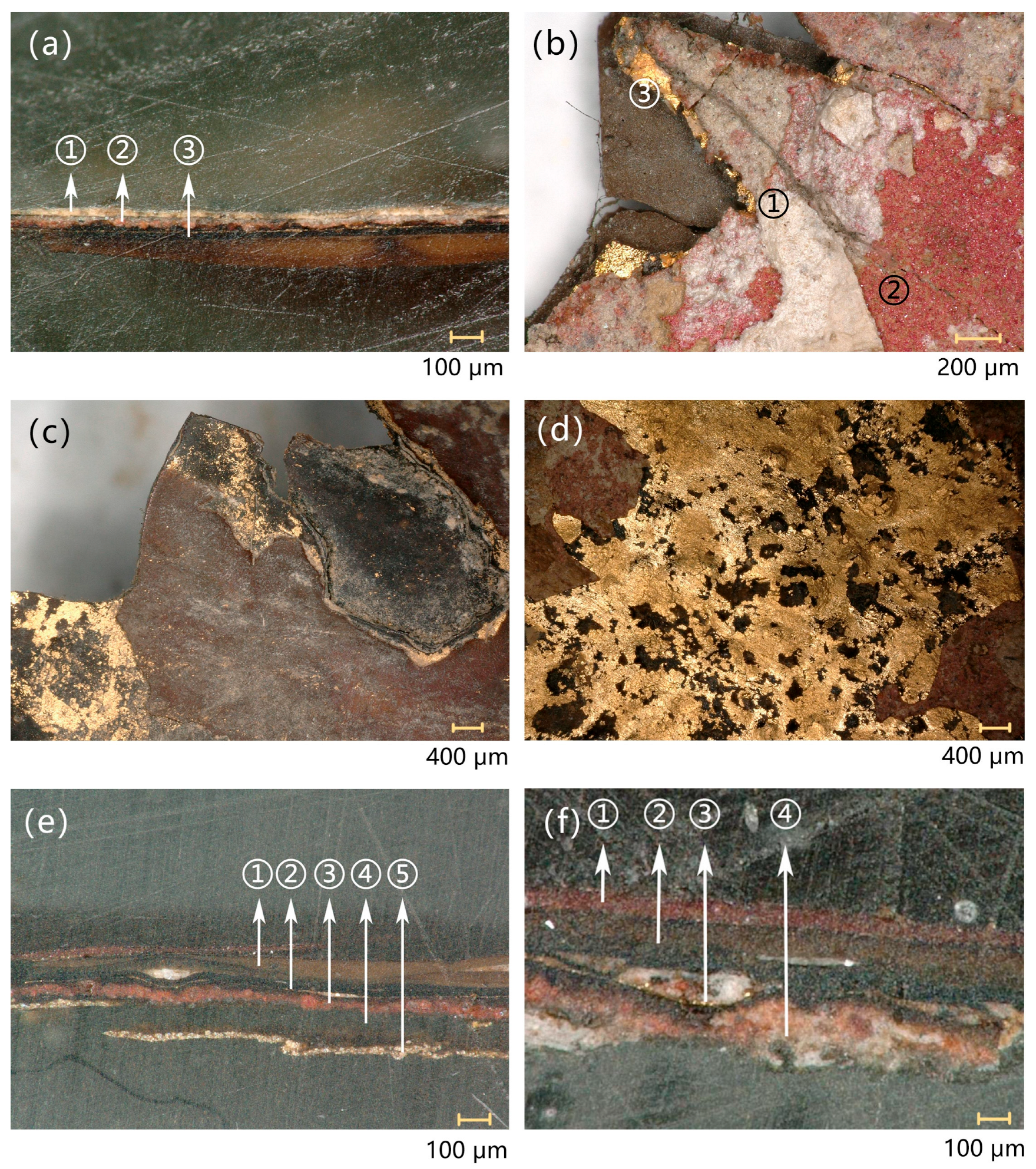

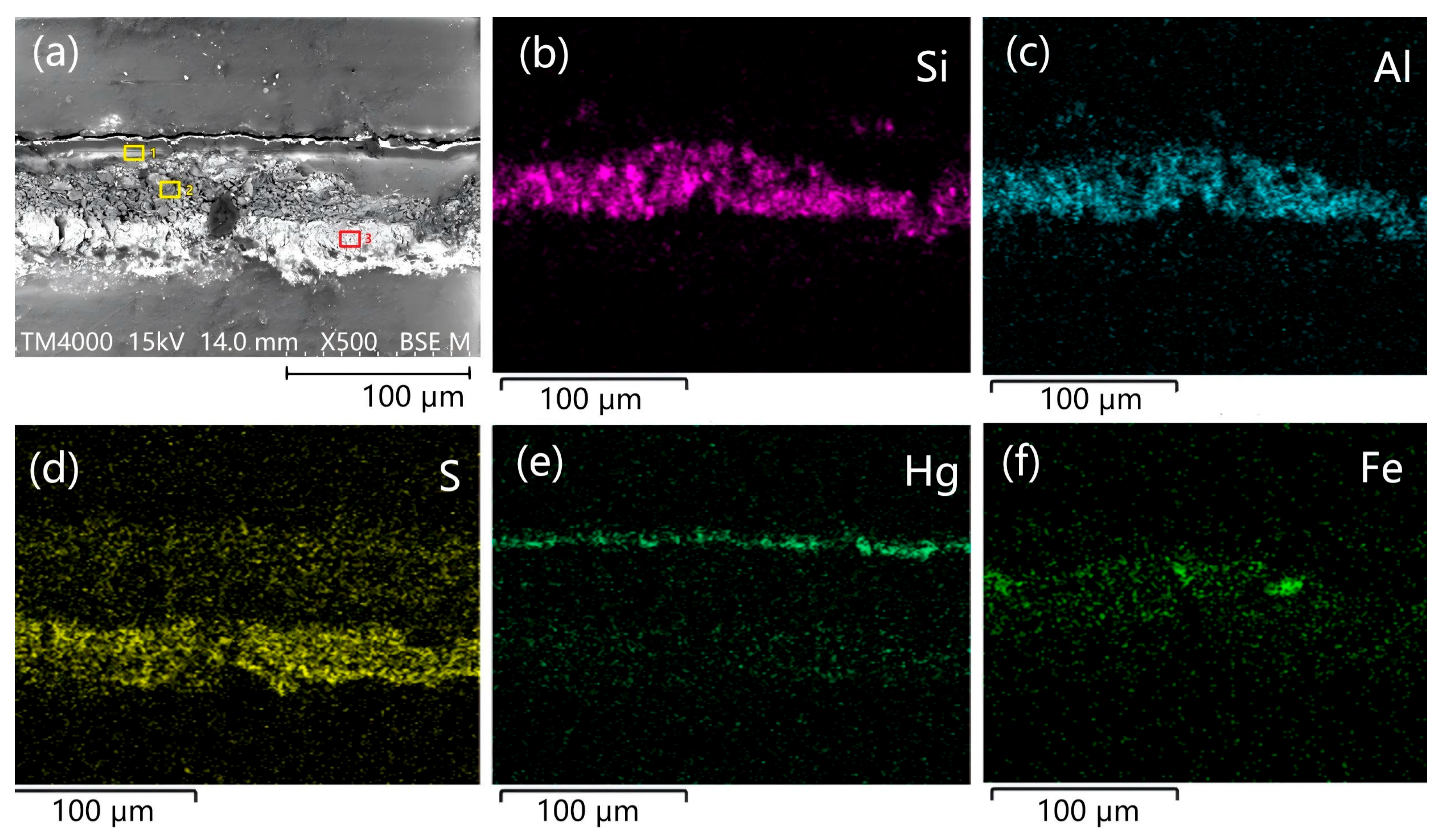
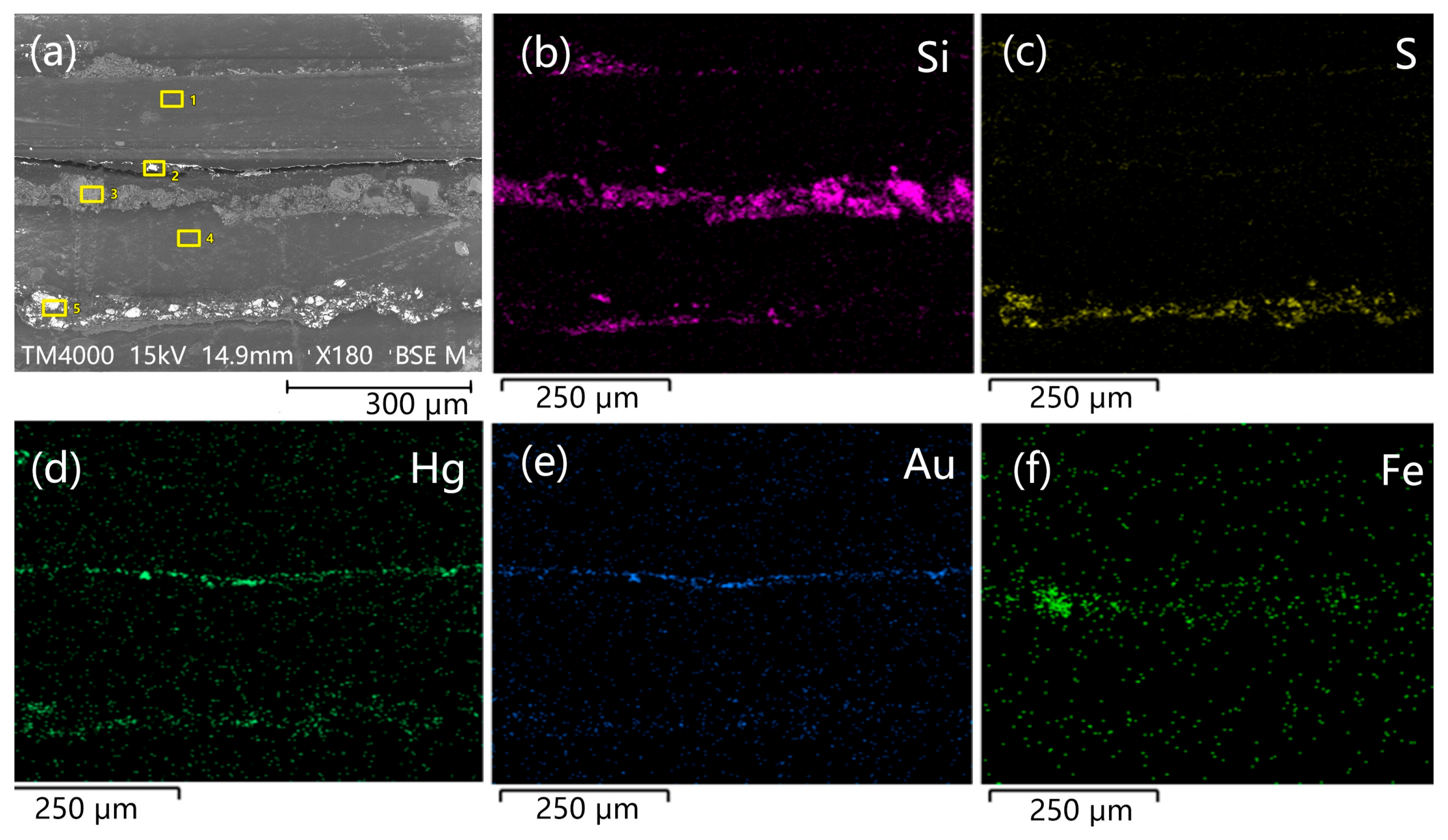

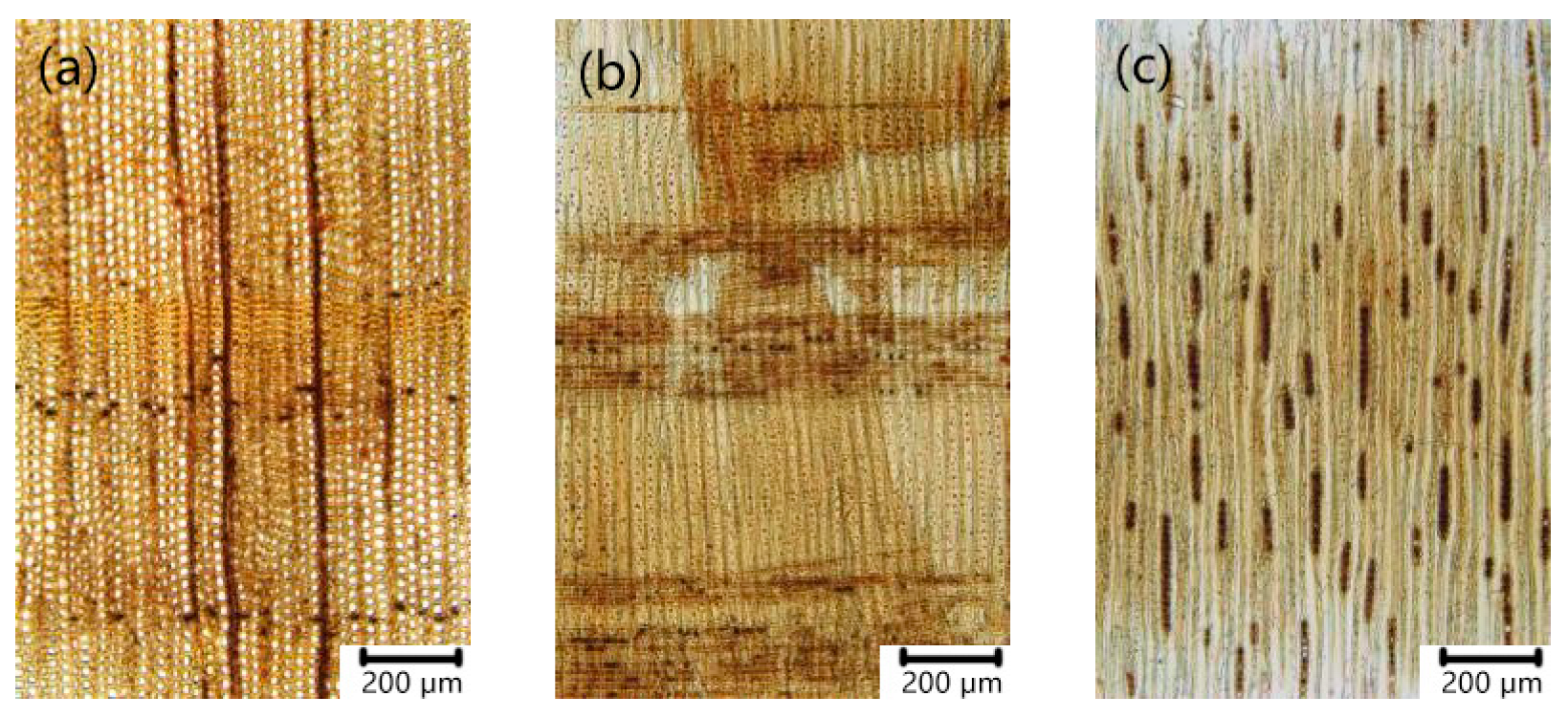

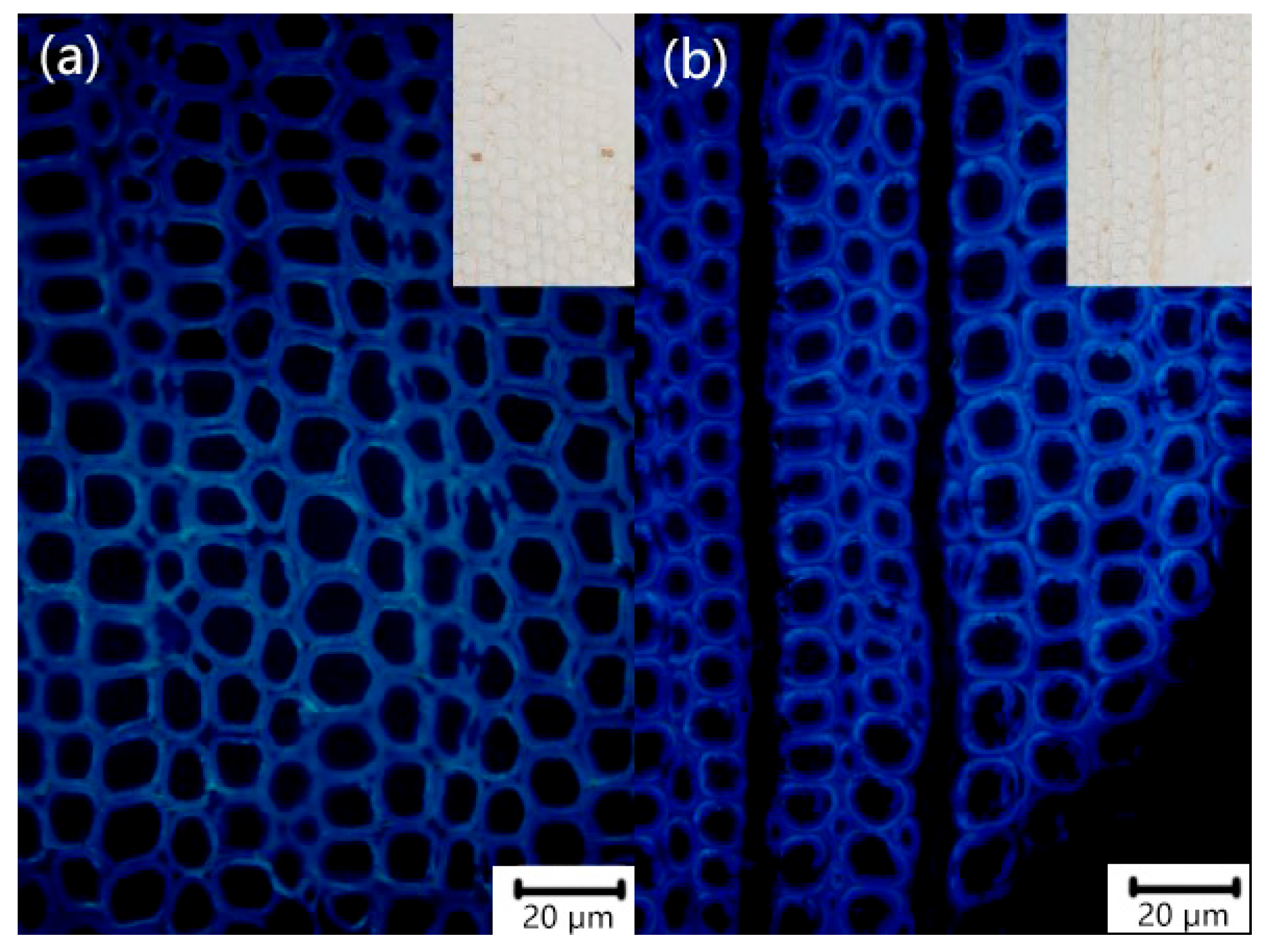
| Sample Number | Sample State | Sample Source | Analysis |
|---|---|---|---|
| S1 | Fragment of the detached decorative layer | Gold-decorated wooden statue 1 | Ultra-depth-of-field microscopic observation (surface and cross-section); SEM-EDS and Raman spectroscopy analysis. |
| S2 | Fragment of the detached decorative layer | Gold-decorated wooden statue 2 | Surface ultra-depth-of field microscopic observation. |
| S3 | Fragment of the detached decorative layer | Gold-decorated wooden statue 2 | Observe the cross-section after the embedding process. SEM-EDS and Raman spectroscopy analysis. |
| S4 | Fragment of the detached decorative layer | Gold-decorated wooden statue 2 | Observe the cross-section after the embedding process and SEM-EDS analysis. |
| S5 | Sample of red pigment particles | Gold-decorated wooden statue 1 | Raman spectroscopy analysis. |
| S6 | Sample of red pigment particles | Gold-decorated wooden statue 2 | Raman spectroscopy analysis. |
| S7 | Wood fragment | Gold-decorated wooden statue 1 | Slice analysis, fluorescence microscopy observation, and NREL component analysis. |
| S8 | Wood fragment | Gold-decorated wooden statue 2 | Slice analysis, fluorescence microscopy observation, and NREL component analysis. |
| Spot | Element Content (wt%) | ||||||||||
|---|---|---|---|---|---|---|---|---|---|---|---|
| C | Cu | Al | Au | Hg | Si | S | Ca | Fe | P | As | |
| 1 black lacquer area | 96.76 | 0.00 | 0.16 | / | 0.00 | 0.75 | 0.09 | 1.52 | 0.72 | / | / |
| 2 brown lacquer area | 65.00 | 0.00 | 3.58 | / | 0.00 | 25.69 | 0.43 | 0.20 | 5.10 | / | / |
| * 3 yellowish-white part | / | 0.00 | 7.64 | 21.32 | 0.00 | 9.62 | 31.89 | 13.48 | 9.73 | 2.37 | 3.95 |
| Spot | Element Content (wt%) | |||||||||
|---|---|---|---|---|---|---|---|---|---|---|
| Cu | Al | Au | Hg | Si | S | Ca | Fe | P | As | |
| 1 | 0.00 | 23.05 | 8.59 | 0.00 | 53.96 | 2.09 | 0.00 | 10.50 | 0.52 | 1.29 |
| 2 | 0.00 | 3.50 | 6.49 | 0.00 | 6.05 | 36.42 | 44.76 | 2.17 | 0.59 | 0.03 |
| 3 | 0.00 | 26.15 | 4.22 | 0.25 | 51.01 | 3.57 | 0.24 | 12.82 | 4.22 | 1.74 |
| Spot | Element Content (wt%) | ||||||||||
|---|---|---|---|---|---|---|---|---|---|---|---|
| C | Cu | Al | Au | Hg | Si | S | Ca | Fe | P | As | |
| 1 brown area | 98.61 | 0.00 | 0.01 | 0.37 | 0.00 | 0.29 | 0.53 | 0.11 | 0.08 | / | / |
| * 2 golden yellow area | / | 0.00 | 0.16 | 96.16 | 0.00 | 0.46 | 1.19 | 0.76 | 1.02 | 0.00 | 0.26 |
| * 3 red area | / | 0.00 | 1.98 | 0.08 | 0.00 | 3.16 | 1.01 | 0.55 | 91.50 | 0.06 | 1.66 |
| 4 black-gray area | 99.17 | 0.00 | 0.22 | 0.00 | 0.13 | 0.37 | 0.04 | 0.04 | 0.04 | / | / |
| * 5 yellowish-white area | / | 0.00 | 1.03 | 1.89 | 0.00 | 2.74 | 36.98 | 0.39 | 0.11 | 0.57 | 56.27 |
| Spot | Element Content (wt%) | ||||||||||
|---|---|---|---|---|---|---|---|---|---|---|---|
| C | Cu | Al | Au | Hg | Si | S | Ca | Fe | P | As | |
| * 1 red paint layer | / | 0.00 | 0.93 | 42.47 | 33.68 | 1.44 | 16.79 | 2.00 | 0.14 | 1.47 | 1.08 |
| 2 brown paint layers | 89.22 | 0.00 | 0.15 | 8.44 | 0.42 | 0.38 | 0.52 | 0.56 | 0.31 | / | / |
| * 3 golden areas | / | 0.00 | 0.80 | 88.37 | 3.18 | 2.92 | 2.09 | 0.70 | 1.88 | 0.06 | 0.00 |
| * 4 pale yellow ash layers | / | 0.00 | 1.83 | 0.21 | 0.00 | 80.87 | 0.07 | 0.00 | 1.47 | 0.21 | 0.41 |
| * 5 pale yellow ash layers | / | 0.00 | 21.58 | 16.81 | 0.00 | 40.13 | 1.61 | 15.82 | 0.18 | 0.79 | 3.08 |
| Sample | Extract/% | Lignin/% | Cellulose/% | Hemicellulose/% | Ash Content/% |
|---|---|---|---|---|---|
| S8 | 14.38 (±0.55) | 28.13 (±2.38) | 28.38 (±1.06) | 9.52 (±0.71) | 6.56 (±2.04) |
| S9 | 15.16 (±0.35) | 32.54 (±1.70) | 19.75 (±0.20) | 11.5 (±0.28) | 7.47 (±1.14) |
Disclaimer/Publisher’s Note: The statements, opinions and data contained in all publications are solely those of the individual author(s) and contributor(s) and not of MDPI and/or the editor(s). MDPI and/or the editor(s) disclaim responsibility for any injury to people or property resulting from any ideas, methods, instructions or products referred to in the content. |
© 2025 by the authors. Licensee MDPI, Basel, Switzerland. This article is an open access article distributed under the terms and conditions of the Creative Commons Attribution (CC BY) license (https://creativecommons.org/licenses/by/4.0/).
Share and Cite
An, Y.; Fang, K.; Pang, M.; Fan, X. Characteristics of the Gold-Decorated Wooden Sculptures of Qing Dynasty Collected in Qianjiang Cultural Administration Institute, Chongqing, China. Coatings 2025, 15, 1163. https://doi.org/10.3390/coatings15101163
An Y, Fang K, Pang M, Fan X. Characteristics of the Gold-Decorated Wooden Sculptures of Qing Dynasty Collected in Qianjiang Cultural Administration Institute, Chongqing, China. Coatings. 2025; 15(10):1163. https://doi.org/10.3390/coatings15101163
Chicago/Turabian StyleAn, Yani, Keyou Fang, Menghua Pang, and Xiaopan Fan. 2025. "Characteristics of the Gold-Decorated Wooden Sculptures of Qing Dynasty Collected in Qianjiang Cultural Administration Institute, Chongqing, China" Coatings 15, no. 10: 1163. https://doi.org/10.3390/coatings15101163
APA StyleAn, Y., Fang, K., Pang, M., & Fan, X. (2025). Characteristics of the Gold-Decorated Wooden Sculptures of Qing Dynasty Collected in Qianjiang Cultural Administration Institute, Chongqing, China. Coatings, 15(10), 1163. https://doi.org/10.3390/coatings15101163





